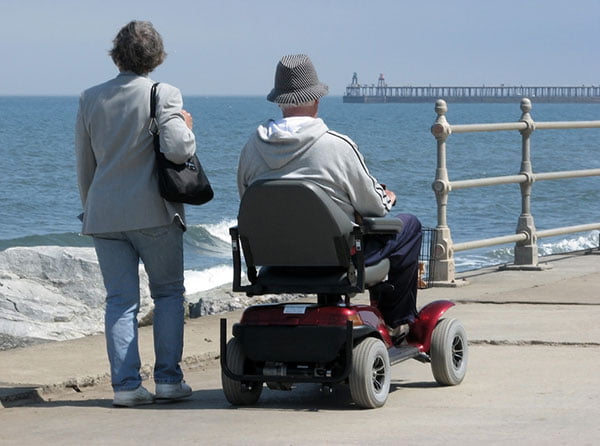What does a flashing light on a mobility scooter mean?
The meaning of a flashing light on a mobility scooter can vary depending on the make and model of the scooter, as well as what kind of light is flashing. Here are some common scenarios in which a light might flash on a mobility scooter:
- Battery Indicator: A flashing light could indicate a low battery or a charging issue. You may need to recharge the scooter’s battery or check the charger.
- Error Code: Some mobility scooters have built-in diagnostic systems that use flashing lights to indicate a problem. The pattern of flashes can be a code that points to a specific issue, such as a motor fault or an electrical problem.
- Safety Warning: Flashing lights could be a built-in safety feature to indicate that the scooter is in reverse or that the user should exercise caution.
- Turn Signals: Some mobility scooters come equipped with turn signals that flash to indicate a turn or lane change. This is usually a manual feature activated by the user.
- Hazard Lights: Like in cars, some scooters have hazard lights that flash simultaneously to indicate that the vehicle is stopped and may be an obstruction.
- Speed Limiter: On some models, a light may flash to indicate that the speed limiter is active, restricting how fast the scooter can go.
If you encounter a flashing light on a mobility scooter and are unsure what it means, it’s essential to consult the user manual for that specific model to get accurate information. Some manuals will provide troubleshooting tips for resolving the issue indicated by the flashing light. If in doubt, it’s always a good idea to contact the manufacturer or a qualified technician for advice.
What does it mean when a mobility scooter beeps?
Beeping sounds on a mobility scooter generally serve as auditory indicators of a particular status or issue. Much like flashing lights, the meaning behind the beeps can vary depending on the make and model of the scooter. Here are some common reasons why a mobility scooter might beep:
- Low Battery: Some scooters beep to alert you when the battery is low or needs recharging.
- Error Codes: Similar to flashing lights, a series of beeps may serve as an error code that indicates a specific issue such as motor malfunction, overheating, or brake failure. The pattern or number of beeps can help diagnose the problem.
- Safety Alert: Some scooters beep when going in reverse as a safety feature to alert pedestrians and other vehicles.
- Speed Warning: Some advanced models may beep to warn the user that they are exceeding the safe speed limit, especially when going downhill.
- Obstruction Alert: If the scooter detects an obstacle or something hindering its movement (like being stuck on an object or a steep slope), it might beep to warn the user.
- Start-up: Some models emit a beep upon being turned on, indicating that they are operational and ready to use.
- Operational Mode Changes: If the scooter has different operational modes (e.g., indoor vs. outdoor, high speed vs. low speed), changing between these modes may be accompanied by a beep to confirm the change.
- Overload: Some scooters may beep to alert the user that they are carrying too much weight, either in the storage compartments or as passengers.
- Connectivity or Signal: In more advanced or smart scooters, a beep might indicate that Bluetooth or another connectivity feature is activated or deactivated.
If your mobility scooter is beeping and you’re not sure why, it’s important to consult the user manual for that specific model for more information. When in doubt, contacting the manufacturer or a qualified technician is advisable for accurate diagnostics and potential solutions.
What is the 9 flash code on a mobility scooter?
A 9-flash error code on a mobility scooter typically indicates a problem with the scooter’s control system. However, the specific meaning of a 9-flash code can vary depending on the brand and model of the mobility scooter. Generally, this error code suggests that a fault has been detected within the scooter’s electronic control unit (ECU) or other essential components. Issues could range from a poor connection between components to a malfunctioning speed controller or throttle potentiometer.
Here are some common steps to troubleshoot a 9-flash error code:
- Check Connections: Ensure that all electrical connections, including battery terminals and motor connections, are secure and in good condition.
- Reset the Scooter: Turn off the scooter and wait for a few moments before turning it back on to see if the error code clears. Some scooters may automatically reset the error code after resolving the issue.
- Consult the Manual: Check the user manual for specific instructions or recommendations for resolving a 9-flash error code on your specific model.
- Contact Support: If the problem persists, it may be best to consult the manufacturer or a qualified technician for further diagnosis and repair.
- Component Testing: Some issues may require testing individual components to determine which part is malfunctioning. This is best done by a qualified technician.
- Software Update: In some advanced models, updating the scooter’s firmware or software may resolve the issue.
- Battery Test: Although less common, an aging or faulty battery can sometimes cause error codes. Ensure that your battery is in good condition.
- Replacement: If a particular component like the ECU or speed controller is found to be defective, it may need to be replaced.
Because the 9-flash error code can indicate a potentially serious issue that may affect the scooter’s safety and performance, it’s essential to address the problem promptly. Always consult the user manual or a qualified technician for the most accurate and personalized advice.


That doesn’t help where do you find the flash codes for a Kymco maxi xls because they are not in the manual like pride scooter manuals